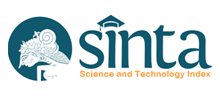Keywords
Self Concept, Interpersonal Communication, Counseling
Document Type
Article
Abstract
This study aims to determine, the self-concept of junior high school students in the city of Yogyakarta and description of the mentoring model for junior high school students in Yogyakarta city based on adolescent self concept. The research method used quantitative method, with descriptive statistical technique. The population of this research is all junior high school students in Yogyakarta city from 15 State Junior High School and 42 Private Junior High. The results is first, the self-concept of students is balanced between those who have low self-concept (222 people: 49.4%), with high self-concept (227 people: 50,6%). Second, from the self concept aspects, the results obtained, have: a) high self-concept/academic self as much as 262 students (58.4%); b) family self concept as high as 257 students (57.2%); c) high physical self-concept, ie 250 students (55.7%); d) low self-concept moral ethics there are 220 students (49%); e) low social self-concept there are 220 students (49%); f) Low self-concept personal there are 216 students (48.1%). Third, the low-tendentious concept of self is ethical-moral, social and personal, then approaches are used for the assistance: a) from the side of interpersonal communication: Self-fulfilling prophecy; opened self; self confidence; and selectivity; b) in terms of interaction style, by developing an enabling interaction style; c) in terms of guidance and counseling services by forming individual guidance and group guidance.
Abstrak
Penelitian ini bertujuan untuk mengetahui konsep diri remaja siswa SMP se kota Yogyakarta dan deskripsi model pendampingan bagi remaja siswa SMP se kota Yogyakarta berdasar konsep diri remaja. Melalui metode kuantitatif, dengan teknik statistik deskriptif. Populasi penelitian ini adalah seluruh siswa SMP se kota Yogyakarta dari 15 SMP Negeri dan 42 SMP Swasta. Hasil penelitian adalah, pertama, konsep diri siswa berimbang antara yang memiliki konsep diri yang rendah (222 orang: 49.4%), dengan yang memiliki konsep diri yang tinggi (yaitu 227 orang: 50.6%). Kedua, dari aspek-aspek konsep diri, diperoleh hasil, yang memiliki: a) konsep diri kerja/akademik yang tinggi sebanyak 262 siswa (58.4%); b) konsep diri keluarga yang tinggi sebanyak 257 siswa (57.2%); c) konsep diri fisik yang tinggi, yaitu 250 siswa (55.7%); d) konsep diri etik moral yang rendah ada 220 siswa (49%); e) konsep diri sosial yang rendah ada 220 siswa (49%); f) konsep diri personal yang rendah ada 216 siswa (48.1 persen). Ketiga, konsep diri yang cenderung rendah adalah konsep diri etik-moral, sosial dan personal, maka digunakan pendekatan bagi pendamping: a) dari sisi komunikasi interpersonal: Nubuat yang dipenuhi sendiri; membuka diri; percaya diri; dan selektivitas; b) dari sisi gaya interaksi, dengan mengembangkan gaya interaksi yang mendorong (enabling); c) dari sisi layanan bimbingan dan konseling dengan membentuk bimbingan kelompok dan bimbingan individual.
First Page
135
Last Page
148
Page Range
135-148
Issue
1
Volume
47
Digital Object Identifier (DOI)
10.21831/informasi.v47i1.15035
Source
15035
Recommended Citation
Widiarti, P. W. (2017). KONSEP DIRI (SELF CONCEPT) DAN KOMUNIKASI INTERPERSONAL DALAM PENDAMPINGAN PADA SISWA SMP SE KOTA YOGYAKARTA. Informasi, 47(1), 135-148. https://doi.org/10.21831/informasi.v47i1.15035
References
Berk, L.E. (1996). Infants, Children and Adolesence.. USA:
Allyn & Bacon Fitzz,W.H. (1971). The Self Concept and Behaviour: Overview and Supplement. Research Monograph. No VII, Library of Congress Catalog Number 72-80269. California.
Hendriati Agustiani. (2009). Psikologi Perkembangan. Bandung : PT Refika Aditama
Hurlock, Elizabeth B. (1980). Psikologi Perkembangan, Suatu Pendekatan Sepanjang Rentang Kehidupan (edisi ke lima). Jakarta : Erlangga
Hall, S. Calvin & Lindzey. G. (1978). Theories of Personality. New York: John Wiley & Sons.
Irene Tarakanita. (2001). “Hubungan Status Identitas Etnik dan Konsep Diri Mahasiswa pada Kelompok Etnik Sunda dan Kelompok Etnik Cina”. Tesis. Bandung: PPS UNPAD.
Jalaludin Rakmat. (2015). (ed 30). Psikologi Komunikasi. Bandung: Remaja Rosda Karya.
Papalia. D.E & S.W. Olds. (1993). A Child’s World, Infancy Through Adolesence.. USA: Mc. Graw-Hill, Inc.
Riswandi. (2013). Psikologi Komunikasi. Yogyakarta: Graha Ilmu.
Steinberg, L. (1993). Adolesence. New York: Mc Graw Hill, Inc.
Syaifuddin Azwar. (2013). Penyusunan Skala Psikologi. Yogyakarta: Pustaka Pelajar.
Triyono. (2013). Metodologi Penelitian Pendidikan. Yogyakarta: Penerbit Ombak.
http://journalbuddies.com/self-esteem-resource/journal-writing-improves-self-esteem/

